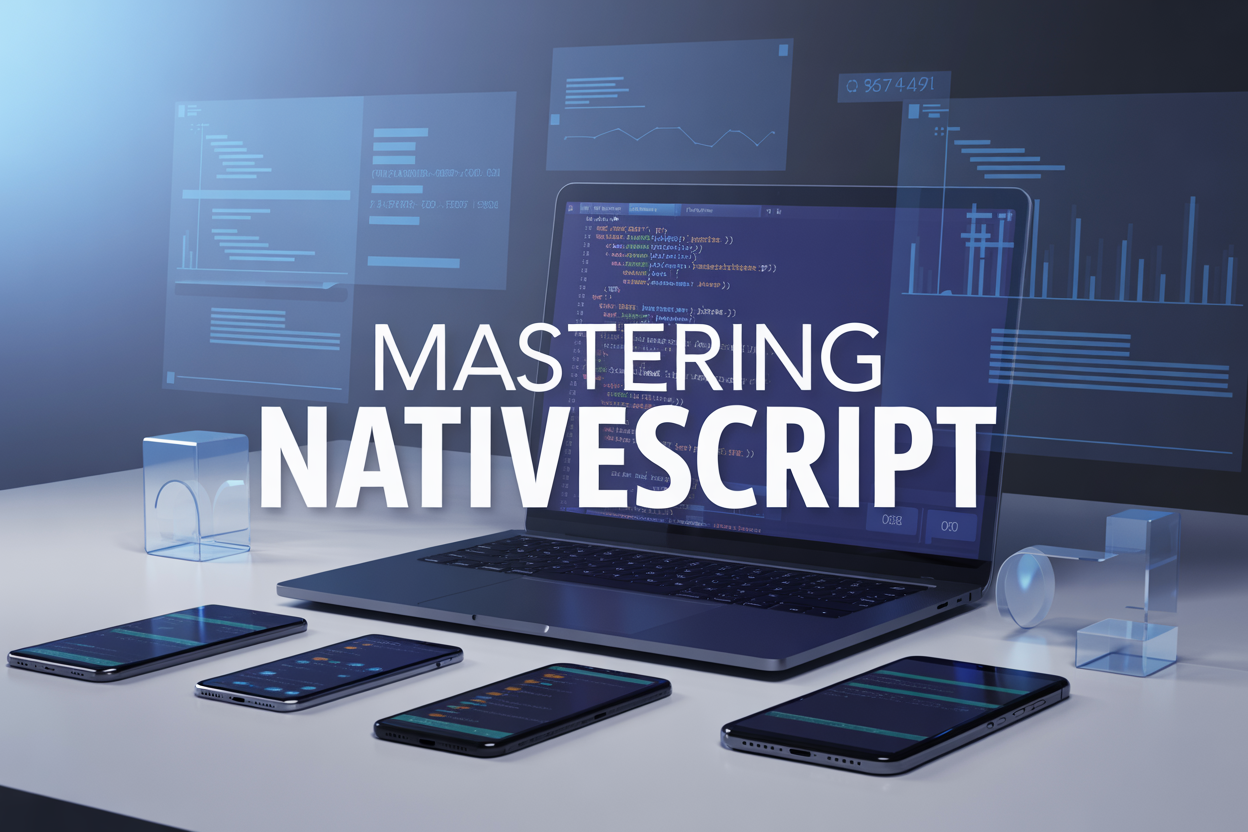NativeScript lets you build truly native mobile apps using web technologies, but getting peak performance requires more than just knowing the basics. This comprehensive guide is designed for intermediate to advanced developers who want to take their cross-platform mobile app development skills to the next level and create apps that perform like native solutions.
You’ll discover how to set up an efficient development environment that streamlines your workflow and eliminates common bottlenecks. We’ll dive deep into mobile app architecture patterns that maximize performance across iOS and Android platforms while maintaining clean, maintainable code.
The guide covers advanced TypeScript NativeScript techniques that boost runtime performance and explores proven strategies for native mobile development that make your apps feel responsive and fluid. You’ll also learn deployment best practices that ensure smooth app store submissions and reliable distribution to your users.
Setting Up Your NativeScript Development Environment for Maximum Efficiency

Choosing the Right IDE and Extensions for Faster Coding
Visual Studio Code stands as the clear winner for NativeScript development, offering robust TypeScript support and an extensive ecosystem of extensions. The NativeScript Extension for VS Code provides intelligent code completion, syntax highlighting, and integrated debugging capabilities that streamline your workflow. Install the TypeScript Hero extension to manage imports automatically and leverage Bracket Pair Colorizer for better code readability in complex UI structures.
For developers who prefer more powerful IDEs, WebStorm delivers advanced refactoring tools and superior TypeScript intelligence. Its built-in terminal integration and Git support make it excellent for larger teams working on cross-platform mobile app development projects. The IDE’s code analysis features catch potential issues before they become runtime problems.
Consider these essential extensions for maximum productivity:
- NativeScript Extension: Core functionality and debugging
- Angular Language Service: Enhanced template support for Angular-based apps
- TSLint: Code quality enforcement
- Auto Import – ES6: Automatic import management
- REST Client: API testing without leaving your editor
Configure your editor with proper themes and font settings to reduce eye strain during long coding sessions. Fira Code or JetBrains Mono provide excellent readability with programming ligatures that make complex TypeScript code easier to parse visually.
Configuring Build Tools and Dependencies for Optimal Performance
Proper build configuration directly impacts your app’s performance and development speed. Start by configuring webpack settings in your webpack.config.js to optimize bundle size and compilation time. Enable tree-shaking to eliminate unused code and configure source maps for better debugging without sacrificing production performance.
Set up your package.json with precise dependency versions to avoid compatibility issues. Pin major versions of critical packages like @nativescript/core and @nativescript/cli to prevent unexpected breaking changes during team development. Use npm’s package-lock.json or Yarn’s lock file to ensure consistent builds across different environments.
Configure your build scripts for different scenarios:
{
"scripts": {
"dev": "ns run android --bundle",
"ios-dev": "ns run ios --bundle",
"build-android": "ns build android --release --copy-to dist/",
"build-ios": "ns build ios --release --copy-to dist/"
}
}
Optimize TypeScript compilation by configuring tsconfig.json with appropriate target settings. Use ES2017 or newer for better performance on modern devices while maintaining compatibility. Enable strict mode to catch potential errors early and improve code quality across your NativeScript development workflow.
Setting Up Device Testing and Debugging Workflows
Effective device testing requires a well-organized approach that covers real devices, emulators, and debugging tools. Connect physical Android and iOS devices for authentic testing experiences, as emulators don’t always replicate real-world performance characteristics accurately.
Configure Android Debug Bridge (ADB) for seamless Android device communication. Install platform-tools and add them to your system PATH for quick device management. For iOS development, ensure Xcode command-line tools are properly installed and your Apple Developer account is configured for device provisioning.
Create debugging profiles for different scenarios:
| Profile Type | Use Case | Configuration |
|---|---|---|
| Development | Active coding | Hot reload enabled, source maps |
| Performance | Optimization testing | Profiling tools, memory monitoring |
| Production | Final testing | Minified code, no debug symbols |
Set up continuous device testing by configuring automated builds that deploy to connected devices. Use NativeScript’s built-in live sync feature for rapid iteration – changes appear instantly on connected devices without full rebuilds. This dramatically speeds up UI development and bug fixing cycles.
Configure network debugging tools like Charles Proxy or Flipper to monitor API calls and identify performance bottlenecks in your mobile app architecture. These tools help diagnose issues that only appear on real devices with actual network conditions.
Creating Project Templates and Boilerplates for Consistent Development
Standardized project templates eliminate repetitive setup tasks and ensure consistent code structure across your development team. Create custom templates that include your preferred folder structure, linting rules, and common dependencies for NativeScript best practices.
Design your template structure around feature-based organization:
src/
├── app/
│ ├── core/
│ ├── shared/
│ ├── features/
│ └── assets/
├── tests/
└── tools/
Include essential configuration files in your boilerplate: .eslintrc, .prettierrc, and custom webpack configurations. Pre-configure common services like HTTP interceptors, error handling, and logging utilities that every project needs. This reduces initial setup time from hours to minutes.
Create multiple template variations for different project types – basic apps, enterprise applications with authentication, and apps with offline capabilities. Each template should include relevant dependencies and example implementations to guide new developers.
Set up npm scripts for common tasks like code generation, testing, and deployment. Include detailed README files with setup instructions and development guidelines specific to your team’s NativeScript development standards. Version control your templates in a separate repository so teams can easily scaffold new projects with proven configurations.
Consider creating generator scripts that prompt developers for project-specific details and customize the template accordingly. This approach combines the speed of boilerplates with the flexibility needed for different client requirements and technical specifications.
Optimizing Application Architecture for Cross-Platform Performance

Implementing MVVM Pattern for Clean Code Separation
The Model-View-ViewModel (MVVM) pattern is a game-changer for NativeScript development, creating clean boundaries between your user interface, business logic, and data management layers. This architectural approach delivers the code separation that makes cross-platform mobile app development maintainable and scalable.
Your View layer handles all UI components – the XML markup, layouts, and visual elements that users interact with. Keep this layer focused purely on presentation, avoiding any business logic or data manipulation code. The ViewModel acts as the bridge between your View and Model, exposing observable properties and commands that the UI can bind to. This layer handles user input, processes data for display, and manages the presentation state.
The Model layer contains your core business logic, data structures, and API interfaces. This is where you define your domain entities, validation rules, and data access patterns that remain consistent across both iOS and Android platforms.
Here’s how to structure your MVVM implementation:
// User.model.ts
export class User {
constructor(
public id: string,
public name: string,
public email: string
) {}
}
// UserViewModel.ts
export class UserViewModel extends Observable {
private _user: User;
get user(): User {
return this._user;
}
set user(value: User) {
if (this._user !== value) {
this._user = value;
this.notifyPropertyChange('user', value);
}
}
}
This separation allows you to write comprehensive unit tests for your ViewModels without touching the UI layer, dramatically improving code quality and reducing bugs in production.
Leveraging Shared Business Logic Across iOS and Android
NativeScript’s biggest advantage lies in writing business logic once and deploying it across multiple platforms. Your shared codebase should contain all core functionality that doesn’t depend on platform-specific features – data validation, API calls, business rules, utility functions, and mathematical calculations.
Create dedicated service classes that handle common operations like user authentication, data synchronization, and business workflows. These services become the backbone of your application, providing consistent behavior regardless of the target platform.
// AuthService.ts
export class AuthService {
private static instance: AuthService;
static getInstance(): AuthService {
if (!AuthService.instance) {
AuthService.instance = new AuthService();
}
return AuthService.instance;
}
async authenticateUser(credentials: LoginCredentials): Promise<AuthResult> {
// Shared authentication logic
const response = await this.httpClient.post('/auth/login', credentials);
return this.processAuthResponse(response);
}
}
Platform-specific code should only handle native features like camera access, file system operations, or platform-specific UI behaviors. Use NativeScript’s platform detection to conditionally execute code:
import { isIOS, isAndroid } from '@nativescript/core';
if (isIOS) {
// iOS-specific implementation
} else if (isAndroid) {
// Android-specific implementation
}
Keep your shared business logic in separate modules that don’t import any UI components. This approach ensures your core functionality remains testable and reusable across different contexts, including potential future platforms or even web applications.
Managing State Effectively with Proper Data Flow Patterns
Effective state management prevents common issues like data inconsistency, memory leaks, and performance bottlenecks in NativeScript applications. Implement unidirectional data flow patterns where state changes flow in a predictable direction through your application.
Use observable properties and data binding to create reactive UIs that automatically update when underlying data changes. NativeScript’s built-in Observable class provides the foundation for this approach:
export class AppState extends Observable {
private _currentUser: User;
private _isLoading: boolean = false;
get currentUser(): User {
return this._currentUser;
}
set currentUser(value: User) {
if (this._currentUser !== value) {
this._currentUser = value;
this.notifyPropertyChange('currentUser', value);
}
}
get isLoading(): boolean {
return this._isLoading;
}
set isLoading(value: boolean) {
if (this._isLoading !== value) {
this._isLoading = value;
this.notifyPropertyChange('isLoading', value);
}
}
}
For complex applications, consider implementing a centralized store pattern similar to Redux or MobX. This creates a single source of truth for your application state and makes debugging much easier. Actions trigger state changes, components subscribe to relevant state slices, and reducers handle the actual state transformations.
Avoid passing large objects through multiple component layers. Instead, use dependency injection or service locator patterns to provide access to shared state and services. This reduces coupling between components and makes your code more maintainable as your application grows.
Memory management becomes critical in mobile environments. Clean up subscriptions, remove event listeners, and dispose of heavy resources when components are destroyed to prevent memory leaks that can crash your NativeScript performance optimization efforts.
Writing High-Performance TypeScript Code in NativeScript

Utilizing Strong Typing for Better Code Quality and Performance
TypeScript brings powerful static typing to NativeScript development, creating a foundation for both cleaner code and better runtime performance. When you define clear types for your variables, function parameters, and return values, the TypeScript compiler can catch errors before they reach production and enable better optimization strategies.
Define interfaces for your data models early in development. This approach helps the JavaScript engine understand object shapes and optimize property access patterns:
interface User {
id: number;
name: string;
email: string;
preferences: UserPreferences;
}
interface UserPreferences {
theme: 'light' | 'dark';
notifications: boolean;
}
Strong typing becomes especially valuable when working with NativeScript’s native APIs. Type definitions help prevent common mistakes like passing incorrect parameter types to native methods, which can cause runtime crashes or unexpected behavior.
Use union types and generics to create flexible yet type-safe APIs. This approach allows your code to be reusable while maintaining compile-time safety:
type ApiResponse<T> = {
success: true;
data: T;
} | {
success: false;
error: string;
};
Enable strict TypeScript compiler options in your tsconfig.json to catch potential issues early. Settings like strictNullChecks and noImplicitAny force you to be explicit about your intentions, leading to more predictable code behavior.
Implementing Efficient Memory Management Techniques
Memory management in NativeScript requires attention to both JavaScript heap usage and native object lifecycle management. Poor memory practices can lead to memory leaks, especially when dealing with native components that don’t follow typical JavaScript garbage collection patterns.
Always clean up event listeners and observers when components are destroyed. NativeScript components often hold references to native objects, and failing to remove these references creates memory leaks:
export class MyComponent {
private subscription: Subscription;
ngOnInit() {
this.subscription = someObservable.subscribe(data => {
// Handle data
});
}
ngOnDestroy() {
if (this.subscription) {
this.subscription.unsubscribe();
}
}
}
Be cautious with circular references, particularly when working with parent-child component relationships. Use WeakMap or WeakSet when you need to associate metadata with objects without preventing garbage collection.
Avoid creating unnecessary object instances in frequently called methods like data binding expressions or scroll event handlers. Instead of creating new objects in templates, prepare data beforehand:
// Avoid this in templates
getDisplayText(item: any) {
return { text: item.name.toUpperCase(), color: item.active ? 'green' : 'red' };
}
// Do this instead
prepareDisplayData(items: any[]) {
return items.map(item => ({
...item,
displayText: item.name.toUpperCase(),
displayColor: item.active ? 'green' : 'red'
}));
}
Monitor memory usage during development using NativeScript’s built-in profiling tools and native debugging capabilities to identify memory bottlenecks before they become production issues.
Optimizing Asynchronous Operations and Promise Handling
Asynchronous operations form the backbone of mobile app responsiveness, but poorly managed async code can block the UI thread and create performance bottlenecks. NativeScript applications need careful async operation handling to maintain smooth user experiences.
Use async/await syntax instead of nested Promise chains for better readability and error handling. This approach makes it easier to manage complex asynchronous workflows:
async loadUserData(userId: string): Promise<User> {
try {
const user = await this.userService.getUser(userId);
const preferences = await this.userService.getUserPreferences(userId);
const avatar = await this.imageService.loadAvatar(user.avatarUrl);
return { ...user, preferences, avatar };
} catch (error) {
console.error('Failed to load user data:', error);
throw new Error('Unable to load user information');
}
}
Implement proper error boundaries and fallback mechanisms for network operations. Mobile applications face unpredictable network conditions, so your async operations should gracefully handle failures:
async fetchDataWithRetry<T>(operation: () => Promise<T>, maxRetries = 3): Promise<T> {
for (let attempt = 1; attempt <= maxRetries; attempt++) {
try {
return await operation();
} catch (error) {
if (attempt === maxRetries) throw error;
await this.delay(1000 * attempt); // Exponential backoff
}
}
}
Batch API calls when possible to reduce network overhead and improve perceived performance. Instead of making multiple individual requests, combine related data fetches into single operations.
Use proper cancellation tokens for long-running operations that users might navigate away from. This prevents unnecessary resource consumption and potential race conditions when components are destroyed before async operations complete.
Leveraging TypeScript Decorators for Cleaner Component Architecture
TypeScript decorators provide a powerful mechanism for adding metadata and behavior to classes, methods, and properties without cluttering your core business logic. In NativeScript development, decorators can significantly improve code organization and reusability.
Create custom property decorators to handle common patterns like data validation or transformation:
function MinLength(min: number) {
return function (target: any, propertyKey: string) {
let value: string;
const getter = () => value;
const setter = (newValue: string) => {
if (newValue.length < min) {
throw new Error(`${propertyKey} must be at least ${min} characters`);
}
value = newValue;
};
Object.defineProperty(target, propertyKey, {
get: getter,
set: setter,
enumerable: true,
configurable: true
});
};
}
Method decorators can encapsulate cross-cutting concerns like logging, caching, or performance monitoring without mixing these concerns with business logic:
function LogPerformance(target: any, propertyKey: string, descriptor: PropertyDescriptor) {
const originalMethod = descriptor.value;
descriptor.value = async function (...args: any[]) {
const start = Date.now();
try {
const result = await originalMethod.apply(this, args);
console.log(`${propertyKey} completed in ${Date.now() - start}ms`);
return result;
} catch (error) {
console.error(`${propertyKey} failed after ${Date.now() - start}ms:`, error);
throw error;
}
};
return descriptor;
}
Class decorators can automate component registration, dependency injection setup, or add common functionality across multiple components. This approach keeps your component classes focused on their primary responsibilities while handling infrastructure concerns through decoration.
Remember that decorators are executed at class definition time, not instance creation time. Use this characteristic to your advantage by performing expensive setup operations once rather than for each instance.
Mastering UI Performance and Native Component Integration

Building Smooth Animations and Transitions
Creating fluid animations in NativeScript requires understanding the core animation APIs and performance implications. The Animation API provides direct access to native animation capabilities, ensuring smooth 60fps performance across platforms.
Use the animate() method on views for simple property changes:
view.animate({
opacity: 0,
duration: 300,
curve: CoreTypes.AnimationCurve.easeInOut
});
For complex animations, leverage the AnimationSet class to orchestrate multiple property changes simultaneously. Always animate transform properties like translateX, translateY, scaleX, and scaleY rather than changing layout properties like width or height, which trigger expensive layout passes.
Page transitions deserve special attention in NativeScript performance optimization. Custom page transitions can significantly impact user experience when implemented correctly. Create reusable transition animations by extending the Transition class and register them globally for consistent behavior across your application.
Avoid animating too many elements simultaneously. Group related animations and use staggered timing to create sophisticated effects without overwhelming the UI thread. The key is batching animation operations and using hardware-accelerated properties whenever possible.
Optimizing Layout Performance with Proper Container Usage
Layout performance directly impacts your app’s responsiveness. Understanding when to use different layout containers can mean the difference between a smooth user experience and frustrating lag.
StackLayout works best for simple vertical or horizontal arrangements with few children. Beyond 10-15 child elements, consider alternatives like ListView or Repeater for dynamic content.
GridLayout excels at complex layouts but becomes expensive with many rows and columns. Define your grid structure once and avoid frequent changes to row/column definitions during runtime.
FlexboxLayout provides powerful CSS flexbox capabilities but requires careful consideration of flex properties. Improper use of flex-grow, flex-shrink, and align-items can cause performance bottlenecks.
| Layout Container | Best Use Case | Performance Impact |
|---|---|---|
| StackLayout | Simple linear arrangements | Low (< 15 children) |
| GridLayout | Complex grid structures | Medium |
| FlexboxLayout | Responsive layouts | Medium-High |
| AbsoluteLayout | Overlapping elements | Low |
| WrapLayout | Wrapping content | High (avoid when possible) |
Always nest layouts judiciously. Each additional layout level adds overhead. Instead of deeply nested structures, consider using a single GridLayout or FlexboxLayout with appropriate positioning properties.
Implementing Custom Native Components When Needed
Sometimes NativeScript’s built-in components don’t meet specific requirements. Creating custom native components bridges this gap while maintaining cross-platform mobile app development efficiency.
Start by extending existing NativeScript components rather than building from scratch. This approach preserves existing functionality while adding custom behavior:
export class CustomButton extends Button {
createNativeView(): Object {
const nativeView = super.createNativeView();
// Add custom native modifications
return nativeView;
}
}
For platform-specific implementations, use the @nativeClass decorator and implement separate Android and iOS versions. This ensures optimal native mobile development performance on each platform.
Custom components should follow NativeScript’s property system using Property and CssProperty classes. This maintains data binding compatibility and ensures proper change detection:
export const customProperty = new Property<CustomView, string>({
name: "customValue",
defaultValue: "",
valueChanged: (target, oldValue, newValue) => {
target.updateNativeView(newValue);
}
});
Remember to properly dispose of native resources in the disposeNativeView() method to prevent memory leaks. This becomes especially important for components that register event listeners or maintain references to native objects.
Managing Screen Orientation and Device-Specific UI Adaptations
Mobile devices come in various screen sizes and orientations. Your NativeScript application must adapt gracefully to these variations without sacrificing performance or user experience.
Handle orientation changes using the Application.orientationChangedEvent. Register early in your app lifecycle to prepare layouts before users notice any jarring transitions:
Application.on(Application.orientationChangedEvent, (args) => {
const orientation = args.newValue;
this.adaptLayoutForOrientation(orientation);
});
Create responsive layouts using percentage-based measurements and flexible containers. Avoid hardcoded pixel values that break on different screen densities. The screen module provides essential device information for making informed layout decisions.
Device-specific adaptations often require different approaches for phones versus tablets. Use screen width breakpoints to determine appropriate layouts:
const screenWidth = screen.mainScreen.widthDIPs;
const isTablet = screenWidth >= 600;
Platform-specific styling becomes crucial for orientation management. Create separate CSS files for different orientations and screen sizes, loading them conditionally based on device characteristics.
Reducing UI Thread Blocking for Better User Experience
The UI thread handles all user interactions and rendering operations. Blocking this thread creates unresponsive interfaces that frustrate users and damage app ratings.
Move heavy computations off the main thread using Workers or async/await patterns. Network requests, file operations, and complex calculations should never run synchronously on the UI thread:
// Bad: Blocks UI thread
const result = heavyComputation(largeDataSet);
// Good: Non-blocking
const result = await this.performHeavyComputationAsync(largeDataSet);
Database operations frequently cause UI thread blocking. Use asynchronous database APIs and implement proper error handling to maintain smooth user interactions even during data operations.
Image loading and processing can severely impact UI performance. Implement image caching strategies and use lazy loading for images outside the viewport. The ImageCache plugin provides efficient image handling with automatic memory management.
ListView and RecyclerView performance depends heavily on efficient item recycling. Keep item templates simple and avoid complex nested layouts within list items. Pre-calculate item heights when possible to eliminate expensive measurement operations during scrolling.
Batch DOM updates when making multiple UI changes. Instead of modifying individual properties sequentially, collect changes and apply them together to minimize layout recalculations and redraws.
Advanced Data Management and API Integration Strategies

Implementing Efficient Local Data Storage Solutions
Choosing the right local data storage approach can make or break your NativeScript performance optimization efforts. SQLite stands out as the gold standard for complex relational data, offering native performance across both iOS and Android platforms. The @nativescript/sqlite plugin provides seamless integration, allowing you to execute complex queries without sacrificing speed.
For simpler key-value storage needs, NativeScript’s Application Settings module delivers lightning-fast performance. This native wrapper around iOS NSUserDefaults and Android SharedPreferences excels at storing user preferences, authentication tokens, and small configuration data. The synchronous API means no callback complexity, making your TypeScript NativeScript code cleaner and more maintainable.
Couchbase Lite emerges as a powerful option for document-based storage with built-in synchronization capabilities. Its NoSQL approach suits modern mobile app development patterns, especially when handling JSON-heavy data structures from REST APIs.
Consider implementing a hybrid storage strategy:
- Application Settings: User preferences, flags, small strings
- SQLite: Complex relational data, large datasets, reporting
- File System: Images, documents, cached content
- Couchbase Lite: JSON documents requiring sync capabilities
Memory management becomes critical with large datasets. Implement lazy loading patterns and dispose of database connections properly. Use prepared statements for repeated queries to boost performance and prevent SQL injection vulnerabilities.
Optimizing Network Requests and Response Handling
Network efficiency directly impacts user experience in cross-platform mobile app development. NativeScript’s HTTP module provides excellent performance, but proper configuration makes the difference between sluggish and snappy applications.
Implement request pooling to prevent overwhelming your backend services. Connection pooling reuses existing connections, reducing handshake overhead. Configure reasonable timeout values—typically 30 seconds for standard requests and longer for file uploads.
const requestOptions = {
url: apiEndpoint,
method: "GET",
headers: {
"Accept": "application/json",
"Authorization": `Bearer ${token}`
},
timeout: 30000
};
Response caching strategies can dramatically improve perceived performance. Implement HTTP cache headers properly and consider client-side caching for frequently accessed data. The @nativescript/background-http plugin handles large file transfers efficiently, preventing UI blocking during uploads or downloads.
Compression reduces bandwidth usage significantly. Enable GZIP compression on your server and configure your NativeScript development environment to handle compressed responses. Most modern APIs support compression by default, but always verify your implementation.
Batch API calls when possible to reduce round trips. Instead of making separate requests for user profile, settings, and notifications, design endpoints that return combined data structures. This approach particularly benefits mobile app performance on slower network connections.
Managing Offline Capabilities and Data Synchronization
Building robust offline capabilities separates professional NativeScript applications from amateur projects. Users expect your app to function regardless of network availability, making offline-first architecture essential for mobile app development success.
Implement a queue-based system for offline actions. When network connectivity drops, queue user actions locally and sync them once connectivity returns. This pattern works particularly well for CRUD operations that don’t require immediate server validation.
The connectivity module helps detect network status changes:
import { Connectivity } from '@nativescript/core';
Connectivity.startMonitoring((connectionType) => {
if (connectionType === Connectivity.connectionType.none) {
// Switch to offline mode
enableOfflineQueue();
} else {
// Process queued actions
syncPendingOperations();
}
});
Data versioning prevents synchronization conflicts. Implement timestamp-based or version-number approaches to handle concurrent modifications. When conflicts arise, provide users with clear resolution options rather than silently overwriting data.
Background sync capabilities ensure data freshness without user intervention. Use NativeScript’s background task capabilities to sync critical data during app suspension or background execution. This approach works especially well for messaging apps, social platforms, and productivity tools.
Consider implementing progressive data loading. Load essential data first, then fetch secondary information as network bandwidth allows. This strategy keeps your app responsive while maximizing data freshness.
Implementing Robust Error Handling and Retry Mechanisms
Professional NativeScript best practices demand comprehensive error handling that gracefully manages network failures, API errors, and unexpected responses. Users notice when apps crash or display cryptic error messages, so robust error management directly impacts user satisfaction.
Implement exponential backoff for retry logic. Start with short delays and progressively increase wait times for subsequent retry attempts. This approach prevents overwhelming struggling servers while maximizing success probability:
async function retryWithBackoff(fn: () => Promise<any>, maxRetries = 3): Promise<any> {
for (let attempt = 1; attempt <= maxRetries; attempt++) {
try {
return await fn();
} catch (error) {
if (attempt === maxRetries) throw error;
const delay = Math.min(1000 * Math.pow(2, attempt - 1), 10000);
await new Promise(resolve => setTimeout(resolve, delay));
}
}
}
Circuit breaker patterns prevent cascade failures when backend services become unavailable. Track failure rates and temporarily disable problematic endpoints, falling back to cached data or alternative services.
Differentiate between recoverable and non-recoverable errors. Network timeouts warrant retry attempts, but authentication failures require immediate user intervention. HTTP status codes provide valuable context for determining appropriate responses.
User-friendly error messages improve the overall experience. Instead of displaying technical error codes, translate common failures into actionable guidance. “Check your internet connection and try again” resonates better than “HTTP 503 Service Unavailable.”
Logging and monitoring help identify patterns in production failures. Implement structured logging that captures request details, error context, and user actions leading to failures. This data proves invaluable for debugging and improving application reliability in your mobile app development workflow.
Testing and Debugging Techniques for Bulletproof Applications

Setting Up Automated Unit Testing Frameworks
Building robust NativeScript applications starts with solid testing foundations. The NativeScript ecosystem supports multiple testing frameworks, with Jasmine being the most popular choice for unit testing. Setting up automated testing begins with installing the necessary dependencies through npm.
Start by configuring Karma as your test runner, which provides excellent browser compatibility and continuous integration support. The @nativescript/unit-test-runner package streamlines the setup process, allowing you to run tests directly on devices or simulators. This approach ensures your tests run in the actual runtime environment where your app will execute.
Structure your test files alongside your source code using the .spec.ts naming convention. This organization makes tests discoverable and maintainable. Mock external dependencies like HTTP services and native device APIs using tools like Sinon.js or Jest mocking capabilities. This isolation ensures your unit tests run quickly and don’t depend on external systems.
Configure your testing pipeline to run automatically on code commits through GitHub Actions or similar CI/CD platforms. This automation catches regressions early and maintains code quality across your development team. Remember to test both business logic and component interactions, focusing on critical user paths and error handling scenarios.
Implementing End-to-End Testing on Real Devices
End-to-end testing validates your entire application flow on actual devices, providing the most realistic testing environment. Appium stands out as the preferred choice for NativeScript development, offering cross-platform testing capabilities for both iOS and Android platforms.
Setting up Appium requires careful configuration of device capabilities and connection parameters. Use real devices whenever possible instead of simulators, as they reveal performance bottlenecks and platform-specific issues that emulators might miss. Cloud-based testing services like BrowserStack or Sauce Labs provide access to diverse device configurations without maintaining physical hardware.
Write your E2E tests using WebDriver protocols, focusing on user journeys rather than implementation details. Test critical workflows like user registration, payment processing, and data synchronization. Implement page object models to organize your test code and make it maintainable as your application grows.
| Testing Tool | Platform Support | Device Access | Best Use Case |
|---|---|---|---|
| Appium | iOS, Android | Real devices, simulators | Cross-platform E2E testing |
| Detox | iOS, Android | Real devices, simulators | React Native and NativeScript |
| Maestro | iOS, Android | Real devices | Simple, fast mobile testing |
Using Advanced Debugging Tools for Performance Analysis
NativeScript development benefits from sophisticated debugging tools that help identify performance bottlenecks and memory leaks. The NativeScript CLI includes built-in debugging capabilities that connect directly to Chrome DevTools, providing familiar debugging experiences for web developers.
Enable source maps in your webpack configuration to debug TypeScript code directly in your browser’s developer tools. This setup allows you to set breakpoints, inspect variables, and step through your code execution line by line. The Network tab helps identify slow API calls and oversized resource downloads that impact app performance.
Memory profiling becomes crucial for long-running applications. Use the Memory tab in Chrome DevTools to capture heap snapshots and identify memory leaks. Pay attention to objects that aren’t being garbage collected properly, especially event listeners and timer references that might persist longer than expected.
The Performance tab provides timeline analysis of your application’s runtime behavior. Record performance profiles during intensive operations like list scrolling or animation sequences. This data reveals frame drops, excessive JavaScript execution time, and layout thrashing that degrades user experience.
For native-level debugging, Xcode and Android Studio provide platform-specific profiling tools. These instruments help diagnose issues with native module integrations and platform-specific performance problems that high-level tools might miss.
Monitoring Application Performance in Production
Production monitoring requires different strategies than development debugging. Real users experience varying network conditions, device capabilities, and usage patterns that testing environments can’t fully replicate. Implementing comprehensive monitoring helps you understand actual app performance and user satisfaction.
Crash reporting services like Bugsnag or Sentry provide automatic error tracking with stack traces and user context. Configure these services to capture both JavaScript errors and native crashes, ensuring no issues slip through unnoticed. Set up alerts for error rate spikes or new error types to respond quickly to production problems.
Performance monitoring tools track key metrics like app launch time, screen transition delays, and API response times. Firebase Performance Monitoring integrates seamlessly with NativeScript applications and provides detailed performance insights across different user segments and device types.
Custom analytics help you understand user behavior and identify performance pain points. Track user flows, feature adoption rates, and session durations to optimize your app’s most important functionality. Implement custom performance markers around critical operations to measure their real-world impact.
Battery usage and memory consumption monitoring become important for user retention. Apps that drain battery or consume excessive memory get uninstalled quickly. Use platform-specific monitoring tools to track resource usage patterns and optimize accordingly.
Consider implementing feature flags to roll out changes gradually and monitor their impact on performance metrics. This approach allows you to quickly revert problematic updates without releasing new app versions.
Deployment and Distribution Best Practices

Optimizing App Bundle Size for Faster Downloads
Bundle size directly impacts user acquisition and retention. Large app downloads frustrate users, especially those with limited data plans or slower connections. NativeScript deployment requires strategic optimization to keep your app lean without sacrificing functionality.
Start with webpack bundling analysis using the --bundle flag during builds. The webpack-bundle-analyzer plugin reveals which modules consume the most space, helping identify bloated dependencies. Remove unused npm packages and consider lighter alternatives – replacing moment.js with date-fns can save 200KB+ from your final bundle.
Tree shaking eliminates dead code automatically, but NativeScript development benefits from manual optimization. Use dynamic imports for features that aren’t immediately needed. Load heavy components, third-party libraries, or complex screens on-demand rather than bundling everything upfront.
Image optimization plays a crucial role in bundle reduction. Compress images using tools like TinyPNG or ImageOptim before including them in your project. Consider using WebP format for Android and HEIF for iOS where supported. Store large assets remotely and download them when needed rather than bundling them directly.
Platform-specific code splitting reduces unnecessary overhead. Use conditional imports and platform checks to include only relevant native modules. Android-specific libraries shouldn’t be bundled for iOS builds and vice versa.
Configure your webpack.config.js to enable aggressive minification and compression. Enable gzip compression for JavaScript bundles and use the UglifyJS plugin with maximum optimization settings. The extra build time pays off with significantly smaller download sizes.
Implementing Continuous Integration and Deployment Pipelines
Automated CI/CD pipelines transform NativeScript deployment from manual chaos into streamlined efficiency. Modern development teams can’t afford manual builds and deployments – the risk of human error is too high, and the time investment doesn’t scale.
GitHub Actions provides excellent NativeScript CI/CD integration. Set up workflows that trigger on pull requests and main branch pushes. Your pipeline should include automated testing, code quality checks, and build generation for both platforms simultaneously.
# Sample workflow structure
- Install dependencies
- Run unit tests
- Execute e2e tests
- Build Android APK/AAB
- Build iOS IPA
- Deploy to staging
- Run smoke tests
- Promote to production
Azure DevOps and Jenkins offer robust alternatives with advanced pipeline management features. Configure separate pipelines for different environments – development, staging, and production should have distinct deployment processes with appropriate security gates.
Cross-platform builds require careful environment management. Use Docker containers to ensure consistent build environments across different CI systems. NativeScript CLI, Android SDK, and Xcode versions must remain synchronized between local development and CI environments.
Implement automated code signing for production releases. Store certificates and provisioning profiles securely using encrypted environment variables or dedicated secret management services. Never commit sensitive credentials to version control systems.
Automated testing integration prevents broken builds from reaching production. Run unit tests, integration tests, and UI automation tests before any deployment. Failed tests should block the pipeline and notify the development team immediately.
Managing App Store Submission and Review Processes
App store submission requires meticulous preparation and strategic planning. Both Google Play Store and Apple App Store have specific requirements that can derail your launch if overlooked during NativeScript development.
Create comprehensive app store assets early in development. Screenshots, app descriptions, and metadata requirements change frequently, so staying updated with current guidelines prevents last-minute scrambling. Design screenshots that highlight your app’s core features across different device sizes.
Apple’s App Store Connect requires detailed privacy policy information, age ratings, and export compliance documentation. Prepare these documents before your first submission. The review process averages 24-48 hours, but complex apps or policy violations can extend this significantly.
Google Play Console offers more flexibility but requires careful attention to target SDK versions and security policies. The staged rollout feature lets you release to small user percentages initially, monitoring for crashes or performance issues before full deployment.
Version management becomes critical with multiple platforms and frequent releases. Implement semantic versioning and maintain clear release notes. Both stores track version history, and users appreciate transparency about new features and bug fixes.
Rejection handling requires systematic approaches. Common rejection reasons include crashes on specific devices, policy violations, or incomplete functionality. Maintain detailed testing matrices covering various devices, OS versions, and network conditions to minimize rejection risk.
| Platform | Average Review Time | Key Requirements |
|---|---|---|
| iOS App Store | 24-48 hours | Privacy policy, age rating, export compliance |
| Google Play | 3-7 hours | Target SDK 33+, privacy policy, content rating |
Beta testing through TestFlight and Google Play Internal Testing provides valuable feedback before public release. Recruit diverse testers across different devices and usage patterns. Their feedback often reveals issues that automated testing misses.
Monitor app store performance metrics post-launch. Download rates, crash reports, and user reviews provide insights for future updates. Both platforms offer analytics dashboards that inform optimization strategies and feature prioritization.

Building high-performance mobile apps with NativeScript doesn’t have to be a struggle when you follow the right approach. From setting up your development environment properly to writing clean TypeScript code, every step matters for creating apps that users love. Smart architecture choices, smooth UI performance, and solid data management strategies form the backbone of successful cross-platform development.
The real secret lies in combining these technical skills with thorough testing and smart deployment practices. When you master these fundamentals, you’ll spend less time fighting bugs and more time building features that matter. Start by picking one area from this guide that needs the most attention in your current project, then gradually work through the others. Your users will notice the difference, and your development process will become much more enjoyable.




















